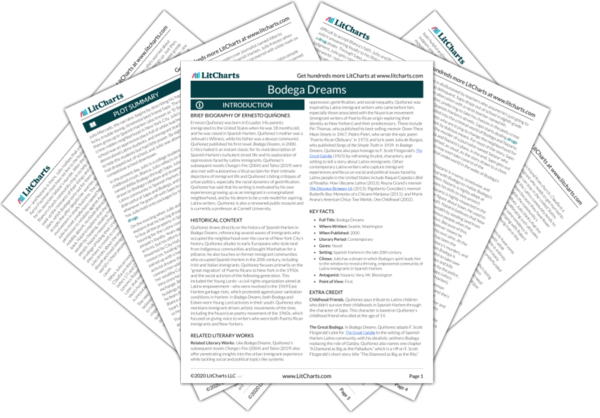Welcome to the LitCharts study guide on Ernesto Quiñones's Bodega Dreams. Created by the original team behind SparkNotes, LitCharts are the world's best literature guides.
Bodega Dreams: Introduction
Bodega Dreams: Plot Summary
Bodega Dreams: Detailed Summary & Analysis
Bodega Dreams: Themes
Bodega Dreams: Quotes
Bodega Dreams: Characters
Bodega Dreams: Terms
Bodega Dreams: Symbols
Bodega Dreams: Theme Wheel
Brief Biography of Ernesto Quiñones

Historical Context of Bodega Dreams
Other Books Related to Bodega Dreams
- Full Title: Bodega Dreams
- Where Written: Seattle, Washington
- When Published: 2000
- Literary Period: Contemporary
- Genre: Novel
- Setting: Spanish Harlem in the late 20th century
- Climax: Julio has a dream in which Bodega’s spirit leads him to the window to reveal a thriving, empowered community of Latinx immigrants in Spanish Harlem.
- Antagonist: Nazario, Vera, Mr. Blessington
- Point of View: First
Extra Credit for Bodega Dreams
Childhood Friends. Quiñonez pays tribute to Latinx children who didn’t survive their childhoods in Spanish Harlem through the character of Sapo. This character is based on Quiñonez’s childhood friend who died at the age of 14.
The Great Bodega. In Bodega Dreams, Quiñonez adapts F. Scott Fitzgerald’s plot for The Great Gatsby to the setting of Spanish Harlem Latinx community, with his idealistic antihero Bodega replacing the role of Gatsby. Quiñonez also names one chapter “A Diamond as Big as the Palladium,” which is a riff on F. Scott Fitzgerald’s short story title “The Diamond as Big as the Ritz.”







